Reflective Practice in Nursing: A Path to Enhanced Patient Care
VerifiedAdded on 2023/06/12
|8
|2133
|345
Essay
AI Summary
This essay presents a position statement on the multifactorial benefits associated with reflective practice in nursing and its successful incorporation into healthcare to ensure best practice. It defines reflective practice, its components, and its effectiveness in clinical settings, weighing the benefits against potential drawbacks. The author argues that reflection is essential for patient safety and meeting quality benchmarks across various care settings. It explores different reflection models like Gibbs, Akin and Murphy, Johns and Rolfe model. The essay highlights how reflective practice promotes autonomous and critical practitioners, improves patient care by reducing medical errors and burnout, and ultimately fosters improved patient safety despite some limitations such as time consumption and lack of guidance. It concludes that continuous skill development through reflective practice is vital for optimal care delivery and compliance with evolving guidelines.
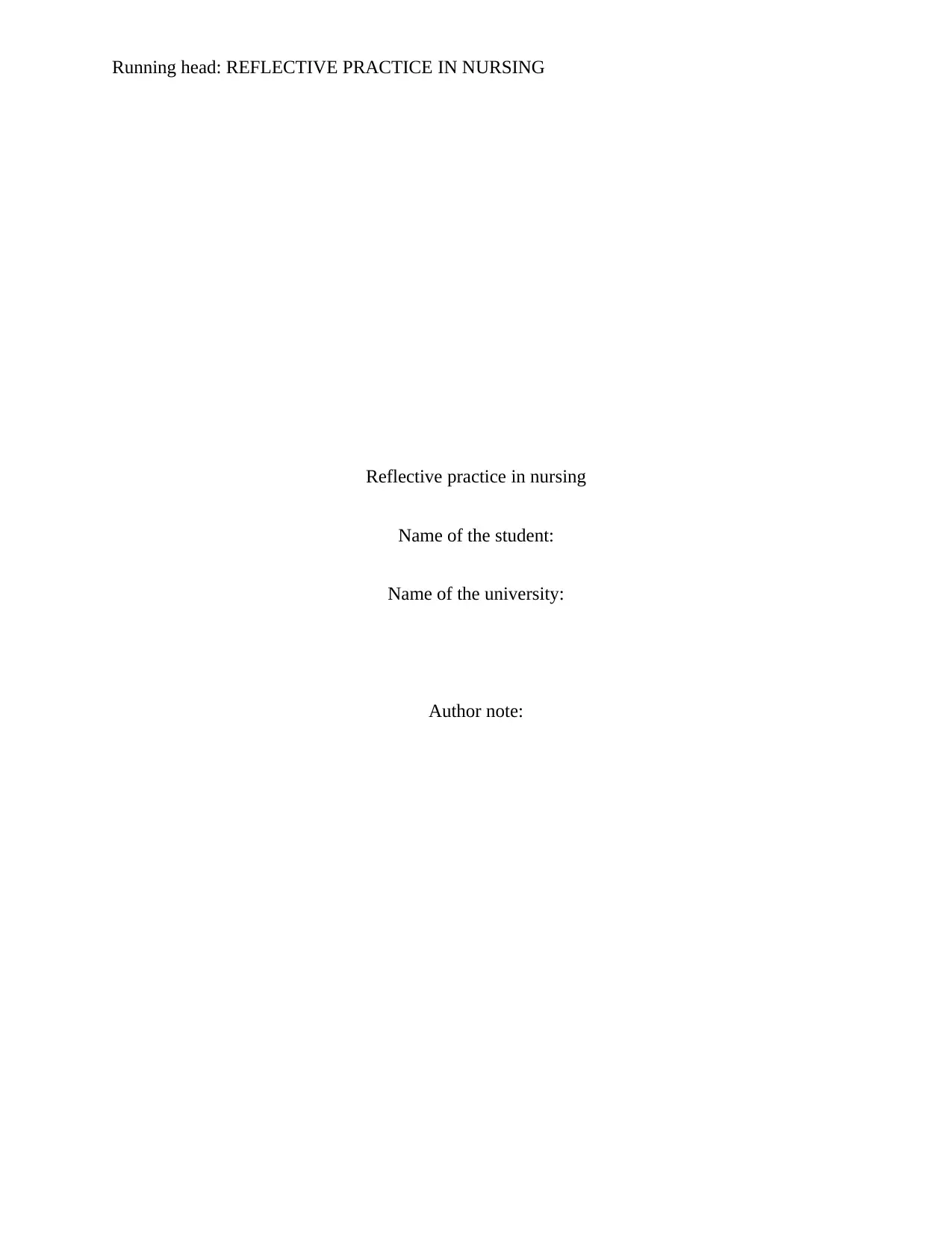
Running head: REFLECTIVE PRACTICE IN NURSING
Reflective practice in nursing
Name of the student:
Name of the university:
Author note:
Reflective practice in nursing
Name of the student:
Name of the university:
Author note:
Paraphrase This Document
Need a fresh take? Get an instant paraphrase of this document with our AI Paraphraser
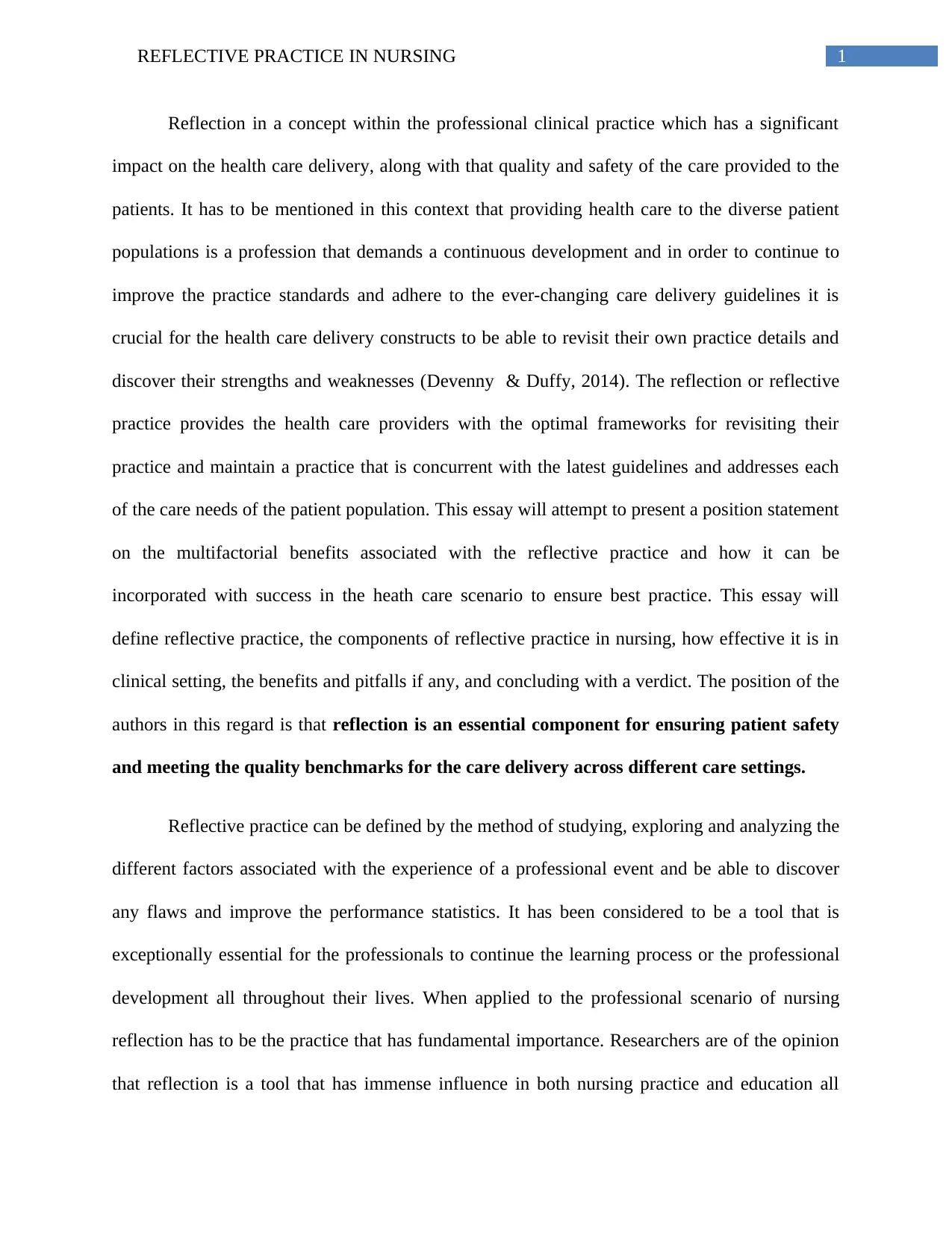
1REFLECTIVE PRACTICE IN NURSING
Reflection in a concept within the professional clinical practice which has a significant
impact on the health care delivery, along with that quality and safety of the care provided to the
patients. It has to be mentioned in this context that providing health care to the diverse patient
populations is a profession that demands a continuous development and in order to continue to
improve the practice standards and adhere to the ever-changing care delivery guidelines it is
crucial for the health care delivery constructs to be able to revisit their own practice details and
discover their strengths and weaknesses (Devenny & Duffy, 2014). The reflection or reflective
practice provides the health care providers with the optimal frameworks for revisiting their
practice and maintain a practice that is concurrent with the latest guidelines and addresses each
of the care needs of the patient population. This essay will attempt to present a position statement
on the multifactorial benefits associated with the reflective practice and how it can be
incorporated with success in the heath care scenario to ensure best practice. This essay will
define reflective practice, the components of reflective practice in nursing, how effective it is in
clinical setting, the benefits and pitfalls if any, and concluding with a verdict. The position of the
authors in this regard is that reflection is an essential component for ensuring patient safety
and meeting the quality benchmarks for the care delivery across different care settings.
Reflective practice can be defined by the method of studying, exploring and analyzing the
different factors associated with the experience of a professional event and be able to discover
any flaws and improve the performance statistics. It has been considered to be a tool that is
exceptionally essential for the professionals to continue the learning process or the professional
development all throughout their lives. When applied to the professional scenario of nursing
reflection has to be the practice that has fundamental importance. Researchers are of the opinion
that reflection is a tool that has immense influence in both nursing practice and education all
Reflection in a concept within the professional clinical practice which has a significant
impact on the health care delivery, along with that quality and safety of the care provided to the
patients. It has to be mentioned in this context that providing health care to the diverse patient
populations is a profession that demands a continuous development and in order to continue to
improve the practice standards and adhere to the ever-changing care delivery guidelines it is
crucial for the health care delivery constructs to be able to revisit their own practice details and
discover their strengths and weaknesses (Devenny & Duffy, 2014). The reflection or reflective
practice provides the health care providers with the optimal frameworks for revisiting their
practice and maintain a practice that is concurrent with the latest guidelines and addresses each
of the care needs of the patient population. This essay will attempt to present a position statement
on the multifactorial benefits associated with the reflective practice and how it can be
incorporated with success in the heath care scenario to ensure best practice. This essay will
define reflective practice, the components of reflective practice in nursing, how effective it is in
clinical setting, the benefits and pitfalls if any, and concluding with a verdict. The position of the
authors in this regard is that reflection is an essential component for ensuring patient safety
and meeting the quality benchmarks for the care delivery across different care settings.
Reflective practice can be defined by the method of studying, exploring and analyzing the
different factors associated with the experience of a professional event and be able to discover
any flaws and improve the performance statistics. It has been considered to be a tool that is
exceptionally essential for the professionals to continue the learning process or the professional
development all throughout their lives. When applied to the professional scenario of nursing
reflection has to be the practice that has fundamental importance. Researchers are of the opinion
that reflection is a tool that has immense influence in both nursing practice and education all
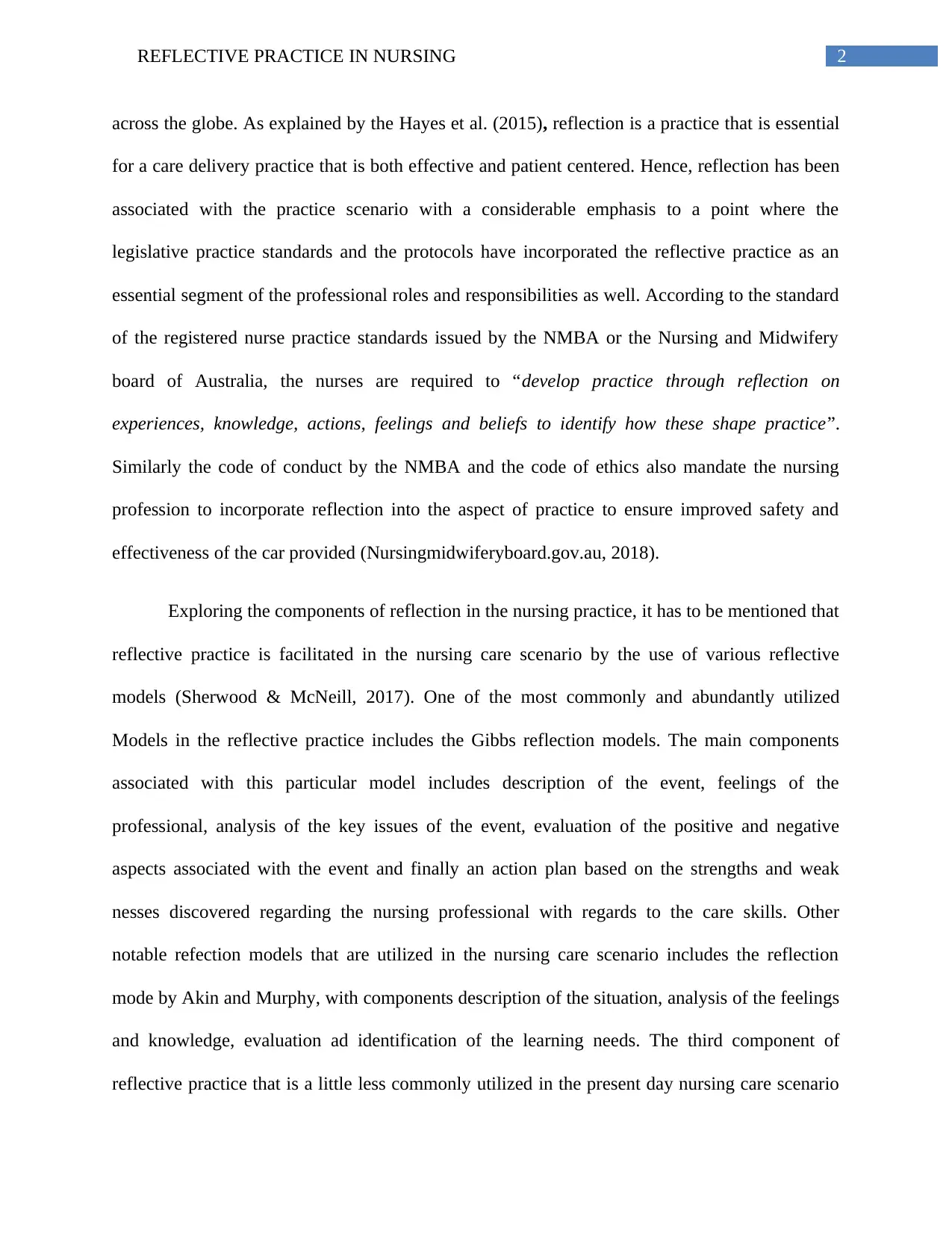
2REFLECTIVE PRACTICE IN NURSING
across the globe. As explained by the Hayes et al. (2015), reflection is a practice that is essential
for a care delivery practice that is both effective and patient centered. Hence, reflection has been
associated with the practice scenario with a considerable emphasis to a point where the
legislative practice standards and the protocols have incorporated the reflective practice as an
essential segment of the professional roles and responsibilities as well. According to the standard
of the registered nurse practice standards issued by the NMBA or the Nursing and Midwifery
board of Australia, the nurses are required to “develop practice through reflection on
experiences, knowledge, actions, feelings and beliefs to identify how these shape practice”.
Similarly the code of conduct by the NMBA and the code of ethics also mandate the nursing
profession to incorporate reflection into the aspect of practice to ensure improved safety and
effectiveness of the car provided (Nursingmidwiferyboard.gov.au, 2018).
Exploring the components of reflection in the nursing practice, it has to be mentioned that
reflective practice is facilitated in the nursing care scenario by the use of various reflective
models (Sherwood & McNeill, 2017). One of the most commonly and abundantly utilized
Models in the reflective practice includes the Gibbs reflection models. The main components
associated with this particular model includes description of the event, feelings of the
professional, analysis of the key issues of the event, evaluation of the positive and negative
aspects associated with the event and finally an action plan based on the strengths and weak
nesses discovered regarding the nursing professional with regards to the care skills. Other
notable refection models that are utilized in the nursing care scenario includes the reflection
mode by Akin and Murphy, with components description of the situation, analysis of the feelings
and knowledge, evaluation ad identification of the learning needs. The third component of
reflective practice that is a little less commonly utilized in the present day nursing care scenario
across the globe. As explained by the Hayes et al. (2015), reflection is a practice that is essential
for a care delivery practice that is both effective and patient centered. Hence, reflection has been
associated with the practice scenario with a considerable emphasis to a point where the
legislative practice standards and the protocols have incorporated the reflective practice as an
essential segment of the professional roles and responsibilities as well. According to the standard
of the registered nurse practice standards issued by the NMBA or the Nursing and Midwifery
board of Australia, the nurses are required to “develop practice through reflection on
experiences, knowledge, actions, feelings and beliefs to identify how these shape practice”.
Similarly the code of conduct by the NMBA and the code of ethics also mandate the nursing
profession to incorporate reflection into the aspect of practice to ensure improved safety and
effectiveness of the car provided (Nursingmidwiferyboard.gov.au, 2018).
Exploring the components of reflection in the nursing practice, it has to be mentioned that
reflective practice is facilitated in the nursing care scenario by the use of various reflective
models (Sherwood & McNeill, 2017). One of the most commonly and abundantly utilized
Models in the reflective practice includes the Gibbs reflection models. The main components
associated with this particular model includes description of the event, feelings of the
professional, analysis of the key issues of the event, evaluation of the positive and negative
aspects associated with the event and finally an action plan based on the strengths and weak
nesses discovered regarding the nursing professional with regards to the care skills. Other
notable refection models that are utilized in the nursing care scenario includes the reflection
mode by Akin and Murphy, with components description of the situation, analysis of the feelings
and knowledge, evaluation ad identification of the learning needs. The third component of
reflective practice that is a little less commonly utilized in the present day nursing care scenario
⊘ This is a preview!⊘
Do you want full access?
Subscribe today to unlock all pages.

Trusted by 1+ million students worldwide
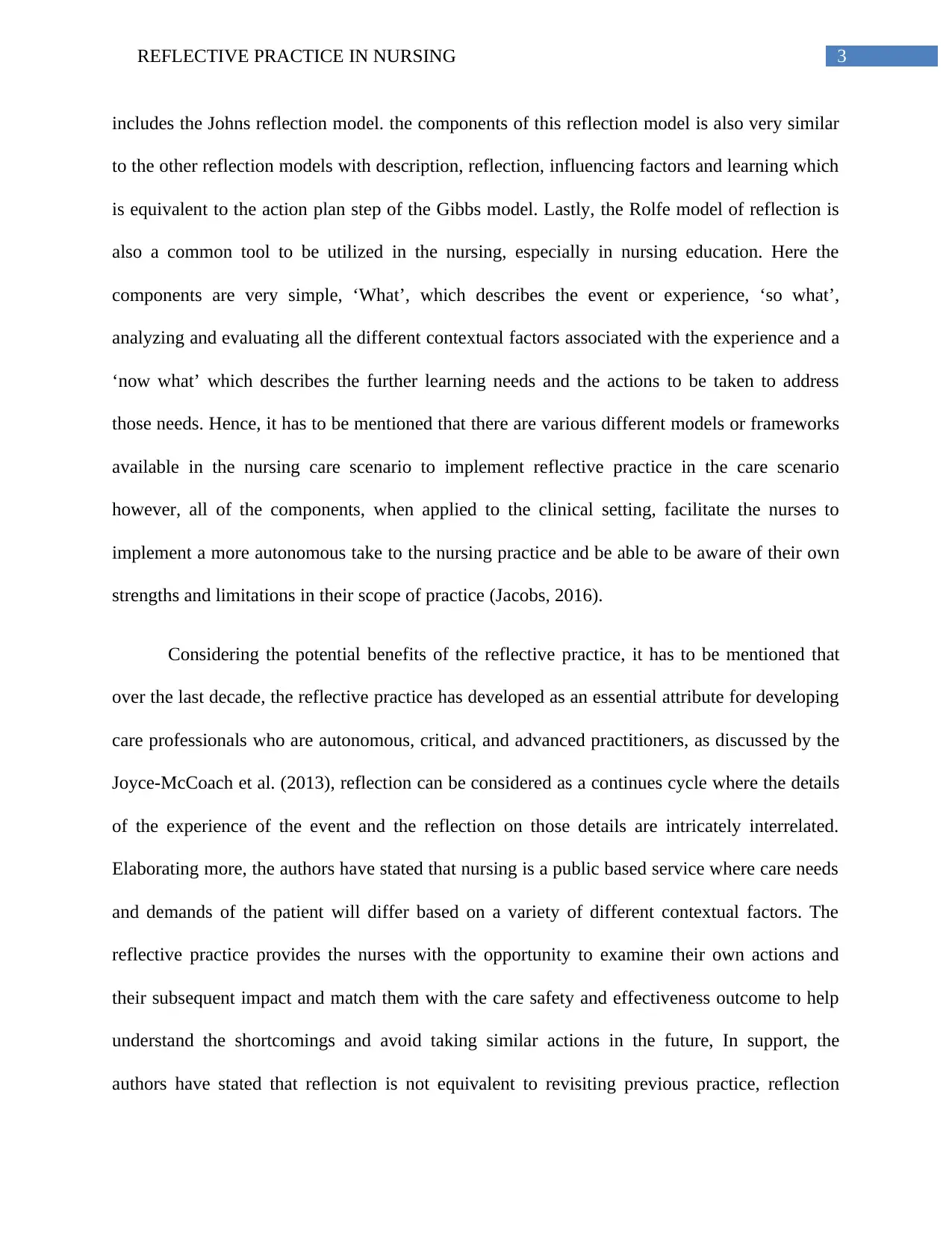
3REFLECTIVE PRACTICE IN NURSING
includes the Johns reflection model. the components of this reflection model is also very similar
to the other reflection models with description, reflection, influencing factors and learning which
is equivalent to the action plan step of the Gibbs model. Lastly, the Rolfe model of reflection is
also a common tool to be utilized in the nursing, especially in nursing education. Here the
components are very simple, ‘What’, which describes the event or experience, ‘so what’,
analyzing and evaluating all the different contextual factors associated with the experience and a
‘now what’ which describes the further learning needs and the actions to be taken to address
those needs. Hence, it has to be mentioned that there are various different models or frameworks
available in the nursing care scenario to implement reflective practice in the care scenario
however, all of the components, when applied to the clinical setting, facilitate the nurses to
implement a more autonomous take to the nursing practice and be able to be aware of their own
strengths and limitations in their scope of practice (Jacobs, 2016).
Considering the potential benefits of the reflective practice, it has to be mentioned that
over the last decade, the reflective practice has developed as an essential attribute for developing
care professionals who are autonomous, critical, and advanced practitioners, as discussed by the
Joyce-McCoach et al. (2013), reflection can be considered as a continues cycle where the details
of the experience of the event and the reflection on those details are intricately interrelated.
Elaborating more, the authors have stated that nursing is a public based service where care needs
and demands of the patient will differ based on a variety of different contextual factors. The
reflective practice provides the nurses with the opportunity to examine their own actions and
their subsequent impact and match them with the care safety and effectiveness outcome to help
understand the shortcomings and avoid taking similar actions in the future, In support, the
authors have stated that reflection is not equivalent to revisiting previous practice, reflection
includes the Johns reflection model. the components of this reflection model is also very similar
to the other reflection models with description, reflection, influencing factors and learning which
is equivalent to the action plan step of the Gibbs model. Lastly, the Rolfe model of reflection is
also a common tool to be utilized in the nursing, especially in nursing education. Here the
components are very simple, ‘What’, which describes the event or experience, ‘so what’,
analyzing and evaluating all the different contextual factors associated with the experience and a
‘now what’ which describes the further learning needs and the actions to be taken to address
those needs. Hence, it has to be mentioned that there are various different models or frameworks
available in the nursing care scenario to implement reflective practice in the care scenario
however, all of the components, when applied to the clinical setting, facilitate the nurses to
implement a more autonomous take to the nursing practice and be able to be aware of their own
strengths and limitations in their scope of practice (Jacobs, 2016).
Considering the potential benefits of the reflective practice, it has to be mentioned that
over the last decade, the reflective practice has developed as an essential attribute for developing
care professionals who are autonomous, critical, and advanced practitioners, as discussed by the
Joyce-McCoach et al. (2013), reflection can be considered as a continues cycle where the details
of the experience of the event and the reflection on those details are intricately interrelated.
Elaborating more, the authors have stated that nursing is a public based service where care needs
and demands of the patient will differ based on a variety of different contextual factors. The
reflective practice provides the nurses with the opportunity to examine their own actions and
their subsequent impact and match them with the care safety and effectiveness outcome to help
understand the shortcomings and avoid taking similar actions in the future, In support, the
authors have stated that reflection is not equivalent to revisiting previous practice, reflection
Paraphrase This Document
Need a fresh take? Get an instant paraphrase of this document with our AI Paraphraser
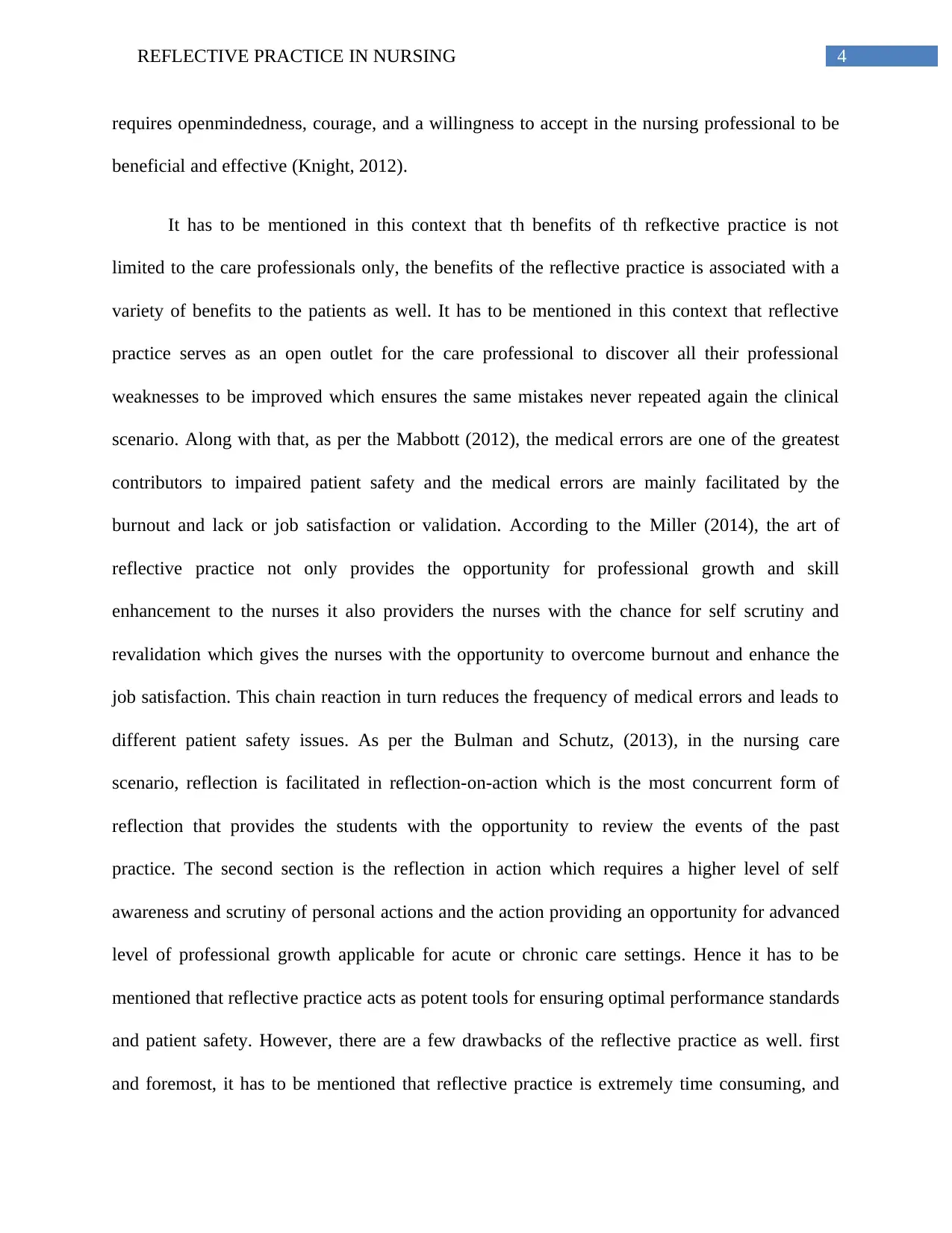
4REFLECTIVE PRACTICE IN NURSING
requires openmindedness, courage, and a willingness to accept in the nursing professional to be
beneficial and effective (Knight, 2012).
It has to be mentioned in this context that th benefits of th refkective practice is not
limited to the care professionals only, the benefits of the reflective practice is associated with a
variety of benefits to the patients as well. It has to be mentioned in this context that reflective
practice serves as an open outlet for the care professional to discover all their professional
weaknesses to be improved which ensures the same mistakes never repeated again the clinical
scenario. Along with that, as per the Mabbott (2012), the medical errors are one of the greatest
contributors to impaired patient safety and the medical errors are mainly facilitated by the
burnout and lack or job satisfaction or validation. According to the Miller (2014), the art of
reflective practice not only provides the opportunity for professional growth and skill
enhancement to the nurses it also providers the nurses with the chance for self scrutiny and
revalidation which gives the nurses with the opportunity to overcome burnout and enhance the
job satisfaction. This chain reaction in turn reduces the frequency of medical errors and leads to
different patient safety issues. As per the Bulman and Schutz, (2013), in the nursing care
scenario, reflection is facilitated in reflection-on-action which is the most concurrent form of
reflection that provides the students with the opportunity to review the events of the past
practice. The second section is the reflection in action which requires a higher level of self
awareness and scrutiny of personal actions and the action providing an opportunity for advanced
level of professional growth applicable for acute or chronic care settings. Hence it has to be
mentioned that reflective practice acts as potent tools for ensuring optimal performance standards
and patient safety. However, there are a few drawbacks of the reflective practice as well. first
and foremost, it has to be mentioned that reflective practice is extremely time consuming, and
requires openmindedness, courage, and a willingness to accept in the nursing professional to be
beneficial and effective (Knight, 2012).
It has to be mentioned in this context that th benefits of th refkective practice is not
limited to the care professionals only, the benefits of the reflective practice is associated with a
variety of benefits to the patients as well. It has to be mentioned in this context that reflective
practice serves as an open outlet for the care professional to discover all their professional
weaknesses to be improved which ensures the same mistakes never repeated again the clinical
scenario. Along with that, as per the Mabbott (2012), the medical errors are one of the greatest
contributors to impaired patient safety and the medical errors are mainly facilitated by the
burnout and lack or job satisfaction or validation. According to the Miller (2014), the art of
reflective practice not only provides the opportunity for professional growth and skill
enhancement to the nurses it also providers the nurses with the chance for self scrutiny and
revalidation which gives the nurses with the opportunity to overcome burnout and enhance the
job satisfaction. This chain reaction in turn reduces the frequency of medical errors and leads to
different patient safety issues. As per the Bulman and Schutz, (2013), in the nursing care
scenario, reflection is facilitated in reflection-on-action which is the most concurrent form of
reflection that provides the students with the opportunity to review the events of the past
practice. The second section is the reflection in action which requires a higher level of self
awareness and scrutiny of personal actions and the action providing an opportunity for advanced
level of professional growth applicable for acute or chronic care settings. Hence it has to be
mentioned that reflective practice acts as potent tools for ensuring optimal performance standards
and patient safety. However, there are a few drawbacks of the reflective practice as well. first
and foremost, it has to be mentioned that reflective practice is extremely time consuming, and
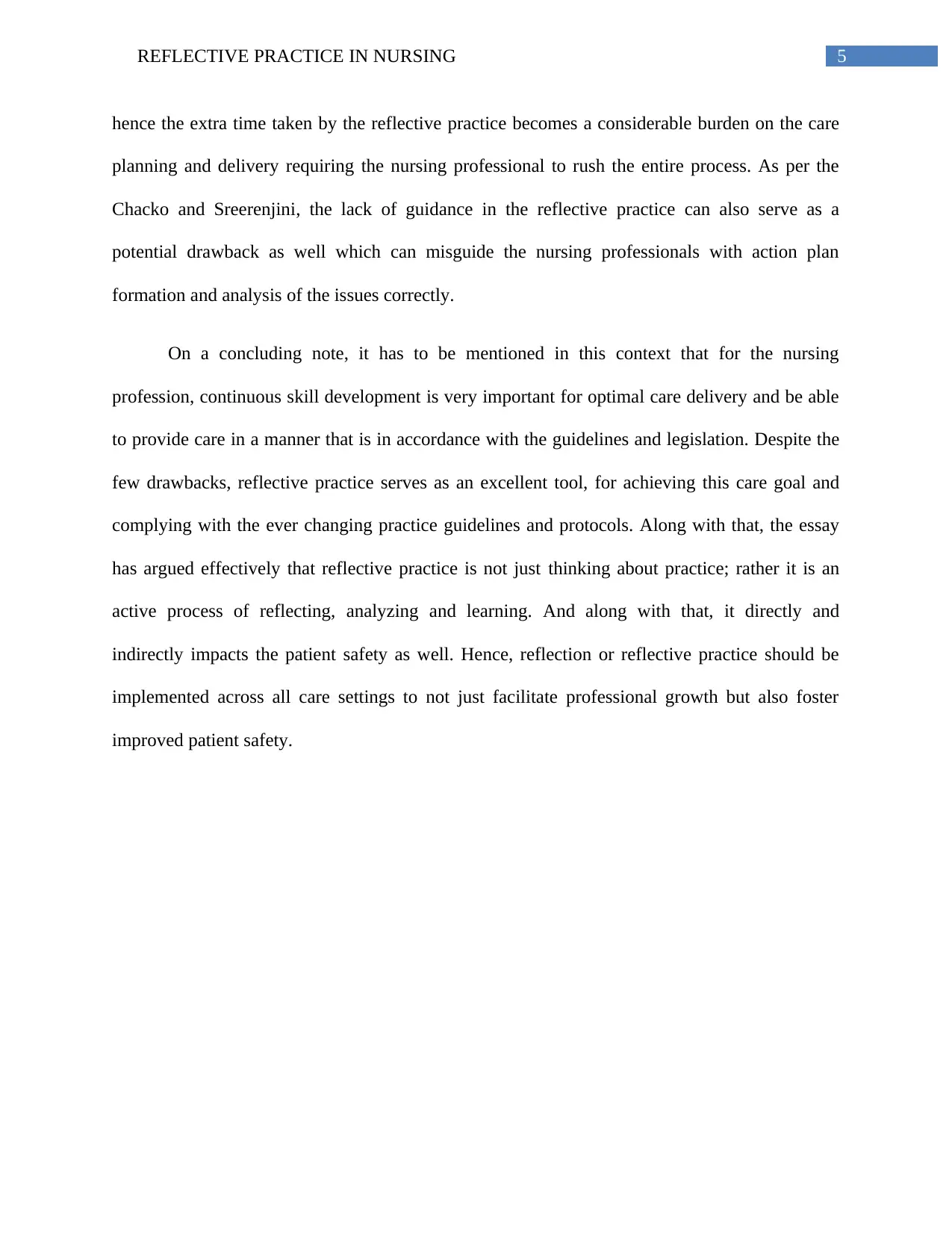
5REFLECTIVE PRACTICE IN NURSING
hence the extra time taken by the reflective practice becomes a considerable burden on the care
planning and delivery requiring the nursing professional to rush the entire process. As per the
Chacko and Sreerenjini, the lack of guidance in the reflective practice can also serve as a
potential drawback as well which can misguide the nursing professionals with action plan
formation and analysis of the issues correctly.
On a concluding note, it has to be mentioned in this context that for the nursing
profession, continuous skill development is very important for optimal care delivery and be able
to provide care in a manner that is in accordance with the guidelines and legislation. Despite the
few drawbacks, reflective practice serves as an excellent tool, for achieving this care goal and
complying with the ever changing practice guidelines and protocols. Along with that, the essay
has argued effectively that reflective practice is not just thinking about practice; rather it is an
active process of reflecting, analyzing and learning. And along with that, it directly and
indirectly impacts the patient safety as well. Hence, reflection or reflective practice should be
implemented across all care settings to not just facilitate professional growth but also foster
improved patient safety.
hence the extra time taken by the reflective practice becomes a considerable burden on the care
planning and delivery requiring the nursing professional to rush the entire process. As per the
Chacko and Sreerenjini, the lack of guidance in the reflective practice can also serve as a
potential drawback as well which can misguide the nursing professionals with action plan
formation and analysis of the issues correctly.
On a concluding note, it has to be mentioned in this context that for the nursing
profession, continuous skill development is very important for optimal care delivery and be able
to provide care in a manner that is in accordance with the guidelines and legislation. Despite the
few drawbacks, reflective practice serves as an excellent tool, for achieving this care goal and
complying with the ever changing practice guidelines and protocols. Along with that, the essay
has argued effectively that reflective practice is not just thinking about practice; rather it is an
active process of reflecting, analyzing and learning. And along with that, it directly and
indirectly impacts the patient safety as well. Hence, reflection or reflective practice should be
implemented across all care settings to not just facilitate professional growth but also foster
improved patient safety.
⊘ This is a preview!⊘
Do you want full access?
Subscribe today to unlock all pages.

Trusted by 1+ million students worldwide
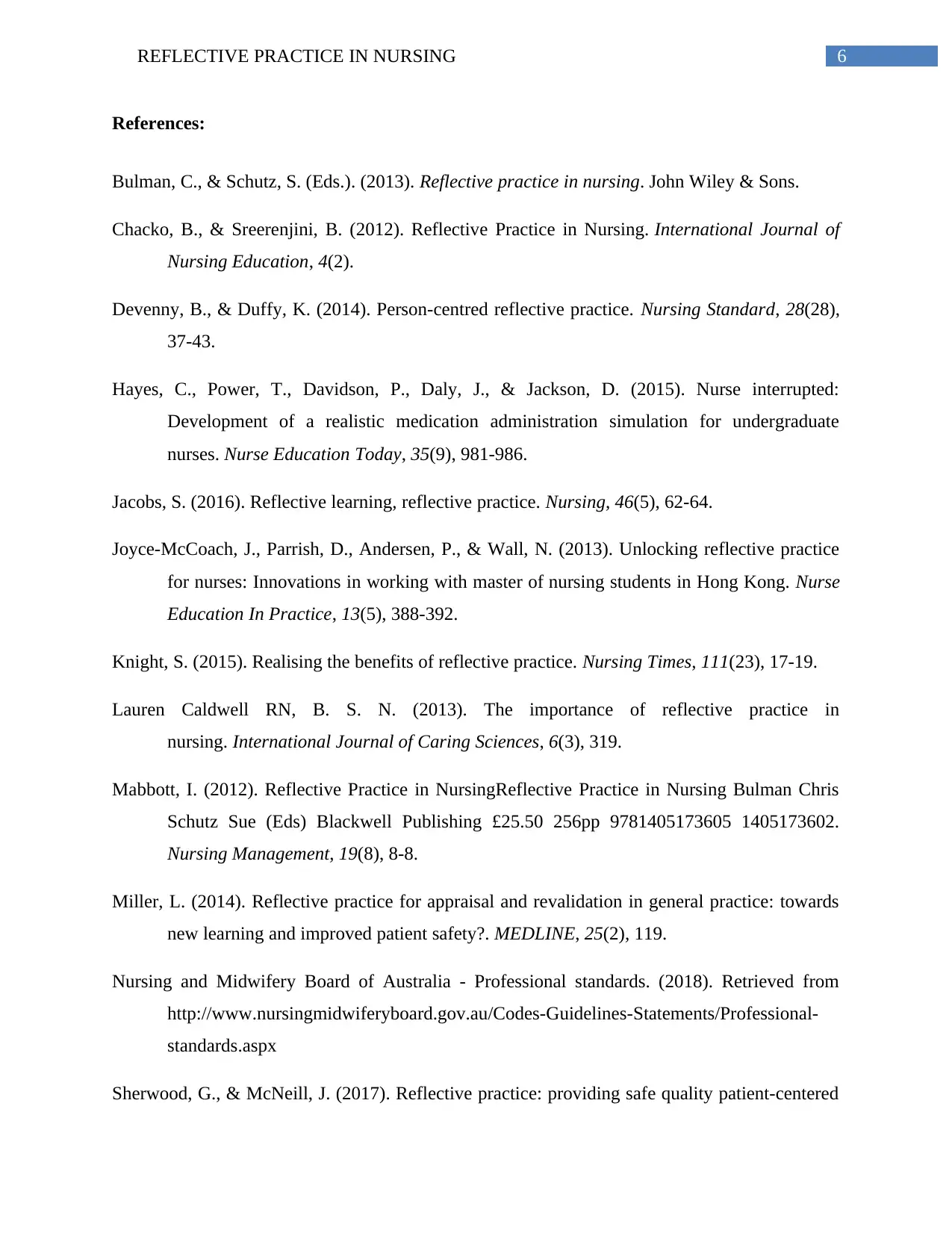
6REFLECTIVE PRACTICE IN NURSING
References:
Bulman, C., & Schutz, S. (Eds.). (2013). Reflective practice in nursing. John Wiley & Sons.
Chacko, B., & Sreerenjini, B. (2012). Reflective Practice in Nursing. International Journal of
Nursing Education, 4(2).
Devenny, B., & Duffy, K. (2014). Person-centred reflective practice. Nursing Standard, 28(28),
37-43.
Hayes, C., Power, T., Davidson, P., Daly, J., & Jackson, D. (2015). Nurse interrupted:
Development of a realistic medication administration simulation for undergraduate
nurses. Nurse Education Today, 35(9), 981-986.
Jacobs, S. (2016). Reflective learning, reflective practice. Nursing, 46(5), 62-64.
Joyce-McCoach, J., Parrish, D., Andersen, P., & Wall, N. (2013). Unlocking reflective practice
for nurses: Innovations in working with master of nursing students in Hong Kong. Nurse
Education In Practice, 13(5), 388-392.
Knight, S. (2015). Realising the benefits of reflective practice. Nursing Times, 111(23), 17-19.
Lauren Caldwell RN, B. S. N. (2013). The importance of reflective practice in
nursing. International Journal of Caring Sciences, 6(3), 319.
Mabbott, I. (2012). Reflective Practice in NursingReflective Practice in Nursing Bulman Chris
Schutz Sue (Eds) Blackwell Publishing £25.50 256pp 9781405173605 1405173602.
Nursing Management, 19(8), 8-8.
Miller, L. (2014). Reflective practice for appraisal and revalidation in general practice: towards
new learning and improved patient safety?. MEDLINE, 25(2), 119.
Nursing and Midwifery Board of Australia - Professional standards. (2018). Retrieved from
http://www.nursingmidwiferyboard.gov.au/Codes-Guidelines-Statements/Professional-
standards.aspx
Sherwood, G., & McNeill, J. (2017). Reflective practice: providing safe quality patient-centered
References:
Bulman, C., & Schutz, S. (Eds.). (2013). Reflective practice in nursing. John Wiley & Sons.
Chacko, B., & Sreerenjini, B. (2012). Reflective Practice in Nursing. International Journal of
Nursing Education, 4(2).
Devenny, B., & Duffy, K. (2014). Person-centred reflective practice. Nursing Standard, 28(28),
37-43.
Hayes, C., Power, T., Davidson, P., Daly, J., & Jackson, D. (2015). Nurse interrupted:
Development of a realistic medication administration simulation for undergraduate
nurses. Nurse Education Today, 35(9), 981-986.
Jacobs, S. (2016). Reflective learning, reflective practice. Nursing, 46(5), 62-64.
Joyce-McCoach, J., Parrish, D., Andersen, P., & Wall, N. (2013). Unlocking reflective practice
for nurses: Innovations in working with master of nursing students in Hong Kong. Nurse
Education In Practice, 13(5), 388-392.
Knight, S. (2015). Realising the benefits of reflective practice. Nursing Times, 111(23), 17-19.
Lauren Caldwell RN, B. S. N. (2013). The importance of reflective practice in
nursing. International Journal of Caring Sciences, 6(3), 319.
Mabbott, I. (2012). Reflective Practice in NursingReflective Practice in Nursing Bulman Chris
Schutz Sue (Eds) Blackwell Publishing £25.50 256pp 9781405173605 1405173602.
Nursing Management, 19(8), 8-8.
Miller, L. (2014). Reflective practice for appraisal and revalidation in general practice: towards
new learning and improved patient safety?. MEDLINE, 25(2), 119.
Nursing and Midwifery Board of Australia - Professional standards. (2018). Retrieved from
http://www.nursingmidwiferyboard.gov.au/Codes-Guidelines-Statements/Professional-
standards.aspx
Sherwood, G., & McNeill, J. (2017). Reflective practice: providing safe quality patient-centered
Paraphrase This Document
Need a fresh take? Get an instant paraphrase of this document with our AI Paraphraser
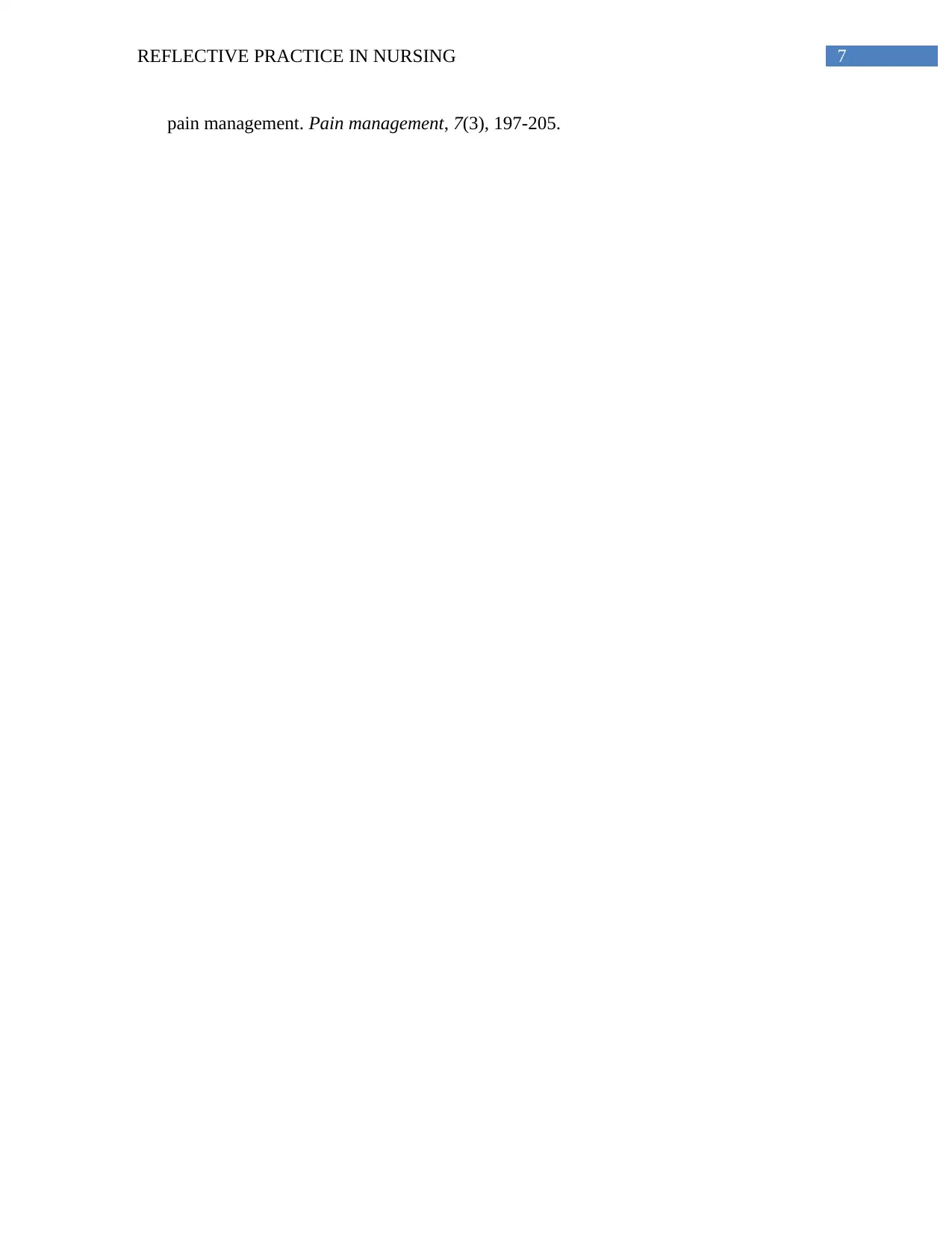
7REFLECTIVE PRACTICE IN NURSING
pain management. Pain management, 7(3), 197-205.
pain management. Pain management, 7(3), 197-205.
1 out of 8
Related Documents
Your All-in-One AI-Powered Toolkit for Academic Success.
+13062052269
info@desklib.com
Available 24*7 on WhatsApp / Email
![[object Object]](/_next/static/media/star-bottom.7253800d.svg)
Unlock your academic potential
Copyright © 2020–2025 A2Z Services. All Rights Reserved. Developed and managed by ZUCOL.





